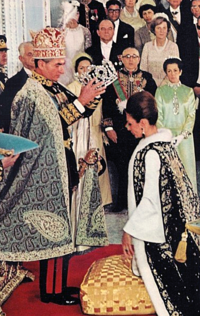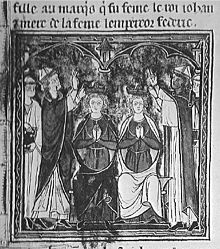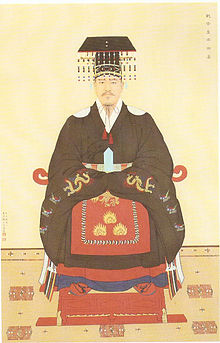- Coronations in Asia
-
- Note: this article is one of a set, describing coronations around the world.
- For general information related to all coronations, please see the umbrella article Coronation.
Coronations in Asia are, or were, held in the following countries:
Contents
By country
Bhutan
Kings of Bhutan are enthroned in a special Buddhist ceremony that involves the offering of various ritual prayers by the new king, the royal family and other notables.[1] The king dons a special diadem known as the "Raven Crown", symbolic not merely of his own authority, but also of the raven-faced protector deity of Bhutan, Legoen Jarog Dongchen.[2] As in neighboring Nepal (prior to 2008), the precise date for the ritual is selected by court astrologers.[3]
Brunei
The Sultanate of Brunei crowns its ruler. The last such coronation was held on 1 August 1968, for the present Sultan, Hassanal Bolkiah in the Lapau, or ceremonial hall. Various items of royal regalia are exhibited at the Royal Regalia Building in the capital of Bandar Seri Begawan.[4]
Cambodia
The King of Cambodia is crowned in a ceremony that combines Brahmanic and Buddhist elements. The new monarch begins his coronation rite inside the Royal Palace in Phnom Penh by placing two wreaths of jasmine atop a golden pillow. Then, bowing before the offerings, he lights a bundle of incense sticks and placed them around the table before taking a seat on the red-carpeted floor. Prayers are read, punctuated by the sound of conch-shell horns. The ruler then enters the Tevea Venichhay Temple, where he lights a stout candle encased in gold-gilded glass. This candle, which represents victory throughout the king's reign, is left burning until the final day of the coronation festival. Nine Buddhist monks then shower the King with jasmine buds. Finally, the monarch makes his way to the throne, bowing three times to it before retreating to his private area of the palace.[5]
The following day commences with the new king taking a ritual bath in water drawn from the Kulen Mountains, whose water is believed by Cambodian royals to be exceptionally pure. The bath is said to wash away the king's impurities, and increase his prestige.[6] The new monarch is carried into the Preah Thineang Dheva Vinnichay, or Throne Hall, of the Palace on a gold chair, at the head of a large procession. Orange-clad Buddhist monks, one for every year of the king's life plus one, chant blessings. The king prays before statues of his ancestors inside the Hall. While priests blow on conch shells outside, the ruler next takes a formal oath to observe the constitution and to rule in the country's best interests. Following this, he receives various items of the royal regalia, including a calico cat, golden slippers, and the jewel-encrusted gold crown and sword.[5][7]
The last such ceremony was held in 2004 for the current monarch, Norodom Sihamoni. Unlike some previous Cambodian rulers, Sihamoni chose not to wear the crown during his coronation.[5]
Iran
The Islamic Shahs of Persia (or Iran, after 1935) crowned themselves in an elaborate coronation ritual staged in Tehran, their capital. The last of these was the coronation of Shah Mohammad Reza Pahlavi of Iran in 1967. The ceremony took place in the Grand Hall of the Golestan Palace, and commenced with the Imam Djomeh reciting several verses from the Qur'an and offering a special coronation prayer. Following this, various items of the Iranian regalia were brought forward. The Shah first received the Emerald Belt, followed by the Imperial Sword and Robe. Finally, the Pahlavi Crown was presented, and the Iranian ruler placed it upon his own head in accordance with Iranian custom. After this, the Shah was given the Imperial Sceptre, after which he crowned his empress and listened to three speeches. The Shah then offered an address of his own, following which he received the homage of all male members of his family.
Japan
The Japanese enthronement ceremony consists of three main parts. The first takes place immediately after the death of the preceding sovereign. The new emperor is given the Three Sacred Treasures of Japan: (1) a replica sword representing the sword Kusanagi-no-Tsurugi (lit. "Grasscutter Sword") (草薙劍)--the original being enshrined the in the Atsuta Shrine in Nagoya; (2) the Yasakani no magatama (八尺瓊曲玉), a necklace of comma-shaped stone beads; and (3) a mirror, called Yata no Kagami (八咫鏡). Unlike most other monarchies, Japan has no crown for its ruler.
The second part of the ceremony is the enthronement ritual itself, held in Kyoto, the former capital of Japan. The ritual is not public, and the regalia itself is generally seen only by the emperor himself and a few Shinto priests.
The Daijo-sai or the Great Thanksgiving Festival is the final inauguration rituals, involving sacred rice, sake, fish and a variety of other foods from both land and sea that are offered to the Sun-goddess Amaterasu-ōmikami. This ceremony effects a singular union with the goddess, thus making the new emperor (in Shinto tradition) the immediate intermediary between Amaterasu-ōmikami and the Japanese people.[8][9]
Jerusalem
The first two Kings of Jerusalem, Baldwin I and Baldwin II, were crowned in the Church of the Nativity in Bethlehem. Between 1131 and 1186, coronations were held in the Church of the Holy Sepulchre. Frederick II, Holy Roman Emperor, was the only king crowned in Jerusalem in the 13th century.[10]
The new monarch was dressed in the palace by the chamberlain. The chamberlain, who bore the royal sword, then headed procession to the Church in which the coronation ceremony took place. The chamberlain then handed the crown, sceptre and the rest of the regalia to the monarch. The coronation was followed by a feast for the noblemen who attended the ceremony.[10]
The regalia possessed by the Kings of Jerusalem, as well as coronation ceremony itself, were influenced by those of Byzantine emperors. The coronation of Baldwin I of Constantinople was notably similar to the coronation of the Kings and Queens of Jerusalem.[10]
Korea
A record of the 1724 coronation of Korean Emperor Yeongjo of the Joseon Dynasty has been preserved. According to this account, Yeongjo began his crowning ritual at noon on 26 October, by entering the funeral chamber where his deceased predecessor, Gyeongjong, lay in state. Having announced to his departed brother that he was assuming the royal mantle, Yeongjo burned incense before his remains, then entered the Injeongjeon Hall, where he was seated upon his throne. In the courtyard below, ranks of servants and bureaucrats bowed to him four times, shouting in unison each time: "Long live the king"! Following this, the new monarch left the throne room and changed back into mourning clothes for the reading of his accession edict. The decree contained the new emperor's pledge to rule justly and benevolently; it equally promised reductions in criminal sentences, provisions for the needy, and gifts for all of Yeongjo's loyal officials. The edict closed with a plea for help and cooperation throughout the reign to come.[11] The Empire of Korea ended in 1910 with annexation by Japan, with the country subsequently splitting into a communist state (North) and republic (South) after the events of World War II.[citation needed]
Laos
Laos crowned its kings, with the last coronation being that of Sisavang Vong at the Royal Palace on 4 March 1905. These rites included rituals in which the king made a symbolic payment to representatives of his people for their land, with them in turn acknowledging his legitimacy.[12] The last King of Laos, Savang Vatthana, was not crowned due to a communist insurgency which led to the abolition of the Laotian monarchy in 1975.[13]
Malaysia
The nine royal rulers of Malaysia elect one of their number every five years to serve as Yang di-Pertuan Agong, or King of Malaysia. The new ruler is enthroned in a special ceremony after his election, which involves usage of several items of regalia including the Tengkolok Diraja, or Royal Headdress—as opposed to a crown. According to legend, the first Sultan of Perak swore off the wearing of any diadems after the miraculous refloating of his ship, which had run aground during his journey to establish his reign in Perak. Hence, while Malaysian coronations are rather elaborate affairs, they do not involve the imposition of a crown. Instead, a special headdress is worn by the new king that since 1957 is in the style of the rulers of the self electing ruler state of Negeri Sembilan.
The new king proceeds into the Istana Negara Throne Hall at the head of a large procession also consisting of his spouse, specially-picked soldiers carrying the royal regalia, and other notables including the Grand Chamberlain, or Datuk Paduka Maharaja Lela. The king and his wife are seated upon their thrones, and the regalia are brought forward. Following this, the Datuk Paduka Maharaja Lela brings forward a copy of the Qur'an, which the new monarch reverently receives, kisses, and places on a special table located between his throne and the queen's. A formal proclamation of the new king's reign is read, followed by the taking of a special coronation oath. The Prime Minister gives a special speech, which is followed by an address by the new king from the throne. A prayer is said, the Qur'an as returned to the Chamberlain, and the ceremony is completed.[14]
Nepal
Kings of Nepal were crowned in a Hindu ceremony whose date was determined by court astrologers. Prior to the actual coronation, eight different kinds of clay were ceremonially applied to various parts of his body, and the new king took a ritual bath in holy water. Afterwards he was sprinkled with clarified butter, milk, curd and honey by representatives of the four traditional Hindu castes: a Brahman, a warrior, a merchant and an Untouchable. Only then was he ready to be crowned.[15] At precisely the "right" moment, the royal priest placed a jewel-studded crown[N 1] on the new king's head. The royals next rode on elephants through the streets of Kathmandu, together with other distinguished guests.
The Nepalese monarchy was abolished in 2008, following several years of pro-democracy and Maoist agitation.
Thailand
Thailand holds a coronation ceremony for its king upon his accession to the throne. The last such ritual was held on 5 May 1950, upon the accession of the current monarch, Bhumibol Adulyadej. This ceremony included several ancient Buddhist and Brahmanic rites, including the presentation of a nine-tiered umbrella (symbol of royal authority) and other items of the royal regalia to the sovereign. Without this, no Thai king can assume the title of "Phrabat" or use the umbrella.[16]
Bhumibol's coronation began with a ceremonial bath, following which the new king put on the white robes of a Brahmin monk, and had sacred water poured over his shoulders while a "gong of victory" was struck by the court astrologer. Afterwards, he received nine pitchers filled with sacred water, drawn from eighteen different sites in Thailand. The nine-tiered umbrella was then presented, followed by five other items of the royal regalia: the Great Crown of Victory, the Sword of Victory, the Royal Staff, the Whisk of the Tail Hairs of a White Elephant, a Small Flat Fan, and a pair of Golden Slippers. In accordance with Thai tradition, Bhumibol placed the crown upon his own head, then received a special golden Ring of Kingship.[17][18]
After this, the new Thai ruler seated himself upon the Bhatarabit Throne at the Grand Palace, where he pronounced the Oath of Accession, promising that he would reign for the benefit and happiness of his people. He also poured ceremonial water to symbolize his complete dedication to his royal responsibilities, in accordance with the "Tenfold Moral Principles of the Sovereign": alms-giving and charity, strict moral standards, self-sacrifice, honesty and integrity, courtesy and kindness, austerity in his habits, harboring no anger or hatred, practicing and promoting non-violence, exuding patience, forbearance and tolerance, and displaying impartiality to all. After this, Bhumibol elevated his wife, Sirikit, to be the Queen of Thailand. Finally, the royal couple visited the Temple of the Emerald Buddha where he made a solemn vow to protect the Buddhist religion.[17]
Notes
This section contains expansions on the main text of the article, as well as links provided for context that may not meet Wikipedia standards for reliable sources, due largely to being self-published.
- ^ A photo of the last Nepalese king, Gyanendra, in coronation regalia may be seen at Cross-Cultural Studies: Ethnographic Performances in Nepal (May 2004).
See also
- Videos of the Malaysian king's coronation Click on "Installation Ceremony" and scroll to bottom of that page for the video link.
References
- ^ "The Chhoetse Penlop — Keys to Bhutan". Keystobhutan.com. http://www.keystobhutan.com/bhutan/bhutan_king_penlop.php. Retrieved 2008-10-12.
- ^ "Bhutan National Symbol, Bhutan Raven Crown — YANA Expeditions, Inc". Yanatravel.com. http://www.yanatravel.com/2008/bhutan-culture/the-raven-crown-origin-and-symbolism.html. Retrieved 2008-10-12.
- ^ "Bhutan to crown its fifth king in November | Reuters". In.reuters.com. 2008-07-23. http://in.reuters.com/article/domesticNews/idINDEL27611820080723. Retrieved 2008-10-12.
- ^ "Jabatan Muzium-Muzium Brunei". Museums.gov.bn. http://www.museums.gov.bn/bangunan2.htm. Retrieved 2008-10-12.
- ^ a b c "Royal Pledges". Camnet.com.kh. http://www.camnet.com.kh/cambodia.daily/coronation/coronation-2.htm. Retrieved 2009-06-20.
- ^ "Cambodian Online News New King Coronation November 2004". Cambodianonline.net. http://www.cambodianonline.net/news2004newking.htm. Retrieved 2008-10-12.
- ^ "King Sihamoni's reign begins". Abc.net.au. October 29, 2004. http://www.abc.net.au/news/newsitems/200410/s1231175.htm. Retrieved 2008-10-12.
- ^ Schoenberger, Karl (1990-11-23). "Akihito in Final Ritual of Passage - Japan: The emperor communes with his mythical ancestor, the Sun Goddess, in a night-time, controversial rite of enthronement. - Los Angeles Times". Articles.latimes.com. http://articles.latimes.com/1990-11-23/news/mn-5212_1_sun-goddess. Retrieved 2009-09-13.
- ^ By STEVEN R. WEISMAN, Special to The New York Times (1990-11-23). "Akihito Performs His Solitary Rite - The New York Times". Nytimes.com. http://www.nytimes.com/1990/11/23/world/akihito-performs-his-solitary-rite.html. Retrieved 2009-09-13.
- ^ a b c Boas, Adrian J. (2001). Jerusalem in the time of the crusades. UK: Routledge. ISBN 0415230004. http://www.questia.com/PM.qst?a=o&d=1105447. Retrieved 2009-06-23.
- ^ Haboush, JaHyun Kim (2001). The Confucian Kingship in Korea: Yŏngjo and the Politics of Sagacity. Columbia University Press. pp. 29–30. ISBN 0231066570. http://books.google.com/?id=aD3VENtRJ4IC&pg=PA29&lpg=PA29&dq=Chinese+coronation+ceremony.
- ^ "Laos — Ethnic Diversity". Countrystudies.us. http://countrystudies.us/laos/49.htm. Retrieved 2008-10-12.
- ^ "The Official Website of Prince Somsanith". Princesomsanith.com. http://www.princesomsanith.com/embroidery.jsp. Retrieved 2008-10-12.
- ^ "Yang di-Pertuan Agong". Malaysianmonarchy.org.my. Archived from the original on May 12, 2008. http://web.archive.org/web/20080512020500/http://www.malaysianmonarchy.org.my/portal_bi/rk4/rk4.htm. Retrieved 2008-10-12.
- ^ Monday, Mar. 10, 1975 (March 10, 1975). "Coronation in Katmandu — TIME". Time.com. http://www.time.com/time/magazine/article/0,9171,917193,00.html. Retrieved 2008-10-12.
- ^ "Pattaya Mail — Pattaya's First English Language Newspaper". Pattayamail.com. http://www.pattayamail.com/457/news.shtml. Retrieved 2008-10-12.
- ^ a b "Pattaya Mail Features". Pattayamail.com. http://www.pattayamail.com/353/features.htm. Retrieved 2008-11-07.
- ^ http://www.cabinet.thaigov.go.th/eng/d_Ninegem00.htm
Categories:
Wikimedia Foundation. 2010.




